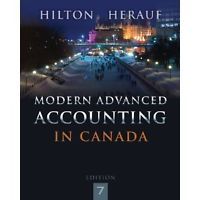Description
Solutions Manual For Advanced Accounting 11th Edition Beams
Chapter 2 STOCK INVESTMENTS — INVESTOR ACCOUNTING AND REPORTING
Answers to Questions
- Only the investor’s accounts are affected when outstanding stock is acquired from existing stockholders. The investor records the investment at its cost. Since the investee company is not a party to the transaction, its accounts are not affected.
Both investor and investee accounts are affected when unissued stock is acquired directly from the investee. The investor records the investment at its cost and the investee adjusts its asset and owners’ equity accounts to reflect the issuance of previously unissued stock.
- Goodwill arising from an equity investment of 20 percent or more is not recorded separately from the investment account. Under the equity method, the investment is presented on one line of the balance sheet in accordance with the one-line consolidation concept.
- Dividends received from earnings accumulated before an investment is acquired are treated as decreases in the investment account balance under the fair value/cost method. Such dividends are considered a return of a part of the original investment.
- The equity method of accounting for investments increases the investment account for the investor’s share of the investee’s income and decreases it for the investor’s share of the investee’s losses and for dividends received from the investee. In addition, the investment and investment income accounts are adjusted for amortization of any investment cost-book value differentials related to the interest acquired. Adjustments to the investment and investment income accounts are also needed for unrealized profits and losses from transactions between the investor and investee companies. A fair value adjustment is optional under SFAS No. 159.
- The equity method is referred to as a one-line consolidation because the investment account is reported on one line of the investor’s balance sheet and investment income is reported on one line of the investor’s income statement (except when the investee has extraordinary gains/losses or gains/losses from discontinued operations). In addition, the investment income is computed such that the parent company’s income and stockholders’ equity are equal to the consolidated net income and consolidated stockholders’ equity that would result if the statements of the investor and investee were consolidated.
- If the equity method of accounting is applied correctly, the income of the parent company will generally equal the controlling interest share of consolidated net income. If the subsidiary is 100% owned by the parent, the parent’s net income under the equity method will equal the consolidated net income of the parent and it’s subsidiary.
- The difference in the equity method and consolidation lies in the detail reported, but not in the amount of income reported. The equity method reports investment income on one line of the income statement whereas the details of revenues and expenses are reported in the consolidated income statement.
- The investment account balance of the investor will equal underlying book value of the investee if (a) the equity method is correctly applied, (b) the investment was acquired at book value which was equal to fair value, the pooling method was used, or the cost-book value differentials have all been amortized or written off as impairment losses, and (c) there have been no intercompany transactions between the affiliated companies that have created investment account-book value differences.
- The investment account balance must be converted from the cost to the equity method when acquisitions increase the interest held to 20 percent or more. The amount of the adjustment is the difference between the investment income reported under the cost method in prior years and the income that would have been reported if the equity method of accounting had been used. The offsetting account in the journal entry is
©2011 Pearson Education, Inc. publishing as Prentice Hall
2-1
2-2 Stock Investments — Investor Accounting and Reporting
Retained Earnings. Changes from the cost to the equity method of accounting for equity investments are changes in the reporting entity that require restatement of prior years’ financial statements when the effect is material.
- The one-line consolidation is adjusted when the investee’s income includes extraordinary items or gains or losses from discontinued operations. In this case, the investor’s share of the investee’s ordinary income is reported as investment income under a one-line consolidation, but the investor’s share of extraordinary items, and gains and losses from discontinued operations is combined with similar items of the investor.
- The remaining 15 percent interest in the investee is accounted for under the fair value/cost method, and the investment account balance immediately after the sale becomes the new cost basis.
- Yes. When an investee has preferred stock in its capital structure, the investor has to allocate the investee’s income to preferred and common stockholders. Then, the investor takes up its share of the investee’s income allocated to common stockholders in applying the equity method. The allocation is not necessary when the investee has only common stock outstanding.
- Goodwill impairment losses are calculated by business reporting units. For each reporting unit, the company must first determine the fair values of net assets. The fair value of the reporting unit is the amount at which it could be purchased in a current market transaction. This may be based on market prices, discounted cash flow analyses, or similar current transactions. This is done in the same manner as is done to originally record a combination. Any excess measured fair value over identifiable assets and liabilities is the implied fair value of goodwill. The company then compares the implied goodwill fair value to the carrying value of goodwill to determine if there has been an impairment loss during the period. If the carrying value exceeds the implied fair value, an impairment loss equal to the difference is recognized.
- Yes. Goodwill impairment losses for subsidiaries are computed as outlined in the solution to question 13. Companies compare fair values to book values for equity method investments as a whole. Firms may recognize impairment losses for equity method investments as a whole, but perform no separate impairment tests for goodwill associated with an equity method investment.
SOLUTIONS TO EXERCISES
Solution E2-1
- d
- c
- c
- d
- b
Solution E2-2 [AICPA adapted]
- d
- b
- d
- b
Gar’s investment is reported at its $600,000 cost because the equity method is not appropriate and because Gar’s share of Med’s income exceeds dividends received since acquisition [($520,000 15%) > $40,000].
©2011 Pearson Education, Inc. publishing as Prentice Hall
|
Chapter 2 |
2-3 |
- c
Dividends received from Zef for the two years were $10,500 ($70,000
15% – all in 2012), but only $9,000 (15% of Zef’s income of $60,000 for the two years) can be shown on Two’s income statement as dividend income from the Zef investment. The remaining $1,500 reduces the investment account balance.
- c
[$100,000 + $300,000 + ($600,000 10%)]
- a
- d
|
Investment balance January |
2 |
$250,000 |
|
|
Add: Income from Pod ($100,000 30%) |
30,000 |
||
|
Investment in Pod December |
31 |
$280,000 |
|
Solution E2-3
- Bow’s percentage ownership in Tre
Bow’s 20,000 shares/(60,000 + 20,000) shares = 25%
- Goodwill
|
Investment cost |
$500,000 |
||
|
Book value ($1,000,000 + $500,000) 25% |
(375,000) |
||
|
Goodwill |
$125,000 |
||
|
Solution E2-4 |
|||
|
Income from Med for 2011 |
|||
|
Share of Med’s income ($200,000 1/2 year 30%) |
$ 30,000 |
||
©2011 Pearson Education, Inc. publishing as Prentice Hall
2-4 Stock Investments — Investor Accounting and Reporting
Solution E2-5
|
1 |
Income from Oak |
|||
|
Share of Oak’s reported income ($800,000 30%) |
$ |
240,000 |
||
|
Less: Excess allocated to inventory |
(100,000) |
|||
|
Less: Depreciation of excess allocated to building |
(50,000) |
|||
|
($200,000/4 years) |
||||
|
$ |
90,000 |
|||
|
Income from Oak |
||||
- Investment account balance at December 31
|
Cost of investment in Oak |
$2,000,000 |
|||
|
Add: Income from Oak |
90,000 |
|||
|
Less: Dividends ($200,000 x 30%) |
(60,000) |
|||
|
Investment in Oak December 31 |
||||
|
$2,030,000 |
||||
|
Alternative solution |
||||
|
$5,000,000 |
||||
|
Underlying equity in Oak at January 1 ($1,500,000/.3) |
||||
|
Income less dividends |
600,000 |
|||
|
Underlying equity December 31 |
||||
|
5,600,000 |
||||
|
Interest owned |
30% |
|||
|
Book value of interest owned December 31 |
||||
|
1,680,000 |
||||
|
Add: Unamortized excess |
350,000 |
|||
|
Investment in Oak December 31 |
||||
|
$2,030,000 |
||||
|
Solution E2-6 |
||||
|
Journal entry on Man’s books |
||||
|
Investment in Nib ($600,000 x 40%) |
240,000 |
|||
|
Loss from discontinued operations |
40,000 |
280,000 |
||
|
Income from Nib |
||||
To recognize income from 40% investment in Nib.
©2011 Pearson Education, Inc. publishing as Prentice Hall
|
Chapter 2 |
2-5 |
Solution E2-7
|
1 |
a |
$ |
18,000 |
|||
|
Dividends received from Ben ($120,000 15%) |
||||||
|
Share of income since acquisition of interest |
(3,000) |
|||||
|
2011 ($20,000 15%) |
||||||
|
2012 ($80,000 15%) |
(12,000) |
|||||
|
Excess dividends received over share of income |
$ |
3,000 |
||||
|
Investment in Ben January 3, 2011 |
$ |
50,000 |
||||
|
Less: Excess dividends received over share of income |
(3,000) |
|||||
|
Investment in Ben December 31, 2012 |
||||||
|
$ |
47,000 |
|||||
|
2 |
b |
|||||
|
$1,400,000 |
||||||
|
Cost of 10,000 of 40,000 shares outstanding |
||||||
|
Book value of 25% interest acquired ($4,000,000 |
||||||
|
stockholders’ equity at December 31, 2011 + |
1,350,000 |
|||||
|
$1,400,000 from additional stock issuance) 25% |
||||||
|
Excess cost over book value(goodwill) |
$ |
50,000 |
||||
- d
The investment in Moe balance remains at the original cost.
- c
|
Income before extraordinary item |
$ |
200,000 |
||
|
Percent owned |
40% |
|||
|
Income from Kaz Products |
||||
|
$ |
80,000 |
|||
|
Solution E2-8 |
||||
|
Preliminary computations |
$2,400,000 |
|||
|
Cost of 40% interest January 1, 2011 |
||||
|
Book value acquired ($4,000,000 40%) |
(1,600,000) |
|||
|
Excess cost over book value |
$ |
800,000 |
||
|
Excess allocated to |
||||
|
$ |
40,000 |
|||
|
Inventories $100,000 40% |
||||
|
Equipment $200,000 40% |
80,000 |
|||
|
Goodwill for the remainder |
680,000 |
|||
|
Excess cost over book value |
||||
|
$ |
800,000 |
|||
|
Ray’s underlying equity in Ton ($5,500,000 40%) |
$2,200,000 |
|||
|
Add: Goodwill |
680,000 |
|||
|
Investment balance December 31, 2016 |
||||
|
$2,880,000 |
||||
|
Alternative computation |
||||
|
Ray’s share of the change in Ton’s stockholders’ |
$ |
600,000 |
||
|
equity ($1,500,000 40%) |
||||
|
Less: Excess allocated to inventories ($40,000 100%) |
(40,000) |
|||
|
Less: Excess allocated to equipment ($80,000/4 years 4 years) |
(80,000) |
|||
|
Increase in investment account |
480,000 |
|||
|
Original investment |
2,400,000 |
|||
|
Investment balance December 31, 2016 |
||||
|
$2,880,000 |
||||





Be the first to review “Solutions Manual For Advanced Accounting 11th Edition Beams”